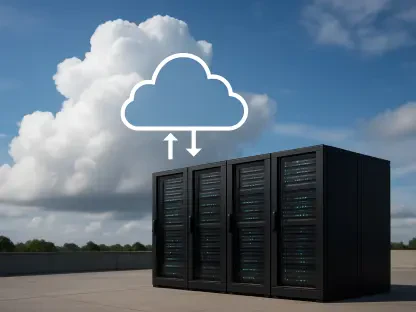The advancement of cloud computing has significantly transformed various sectors, but its impact on higher education is particularly profound. Educational institutions are increasingly adopting cloud-based platforms such as SaaS (Software as a Service), IaaS (Infrastructure as a Service), and PaaS (Platform as a Service) to enhance teaching methodologies and streamline administrative tasks. This shift promises to revolutionize traditional educational frameworks, providing a more efficient and inclusive learning environment.
The Role of Cloud Computing During the COVID-19 Pandemic
Ensuring Continuity Through Virtual Classrooms
The COVID-19 pandemic accelerated the adoption of cloud computing in education as physical campuses closed, thrusting universities and colleges into an online-only format almost overnight. Cloud platforms became a lifeline for educational continuity, as they facilitated the centralized storage of course materials, supported virtual classrooms, and enabled real-time communication between students and educators. The transition was not seamless, but the flexibility and adaptability of cloud technologies ensured that learning could continue without significant disruption. Through platforms like Zoom, Microsoft Teams, and Google Classroom, institutions managed to replicate in-person lectures and discussions, albeit in a virtual environment.
The shift to cloud-enabled online learning also revealed new opportunities for both educators and students. Educators could use a variety of digital tools to create more engaging content, and students had the advantage of accessing learning materials from any location. This newfound flexibility extended beyond mere convenience; it expanded educational access to students who might have otherwise faced geographical or logistical barriers. The pandemic underscored the importance of integrating cloud technologies not just as a contingency plan, but as a permanent feature of modern education.
Financial Advantages and Resource Reallocation
Financial constraints have always been a significant concern for educational institutions, particularly when it comes to investing in technological infrastructure. By transitioning to cloud services, institutions can significantly reduce costs associated with maintaining on-premises hardware and software. The financial savings are substantial, allowing these funds to be reallocated to other critical areas such as improving the quality of education, research, and student support services. Institutions no longer have to invest heavily in physical servers or IT maintenance; instead, they can rely on cloud providers who offer scalable and cost-effective solutions.
Moreover, cloud-based platforms offer pay-as-you-go services, meaning educational institutions only pay for what they use. This model is particularly advantageous for schools with fluctuating resource needs throughout the academic year. The financial benefits go hand-in-hand with operational efficiencies. Cloud platforms provide automated updates and maintenance, reducing the burden on IT staff and enabling them to focus on more strategic initiatives. With these advantages, cloud computing becomes a compelling choice for modernizing higher education.
Challenges and Concerns
Addressing Data Security and Privacy
While the adoption of cloud computing brings numerous benefits, it is not without its challenges. Data security remains one of the foremost concerns, especially given the sensitive nature of the information handled by educational institutions. Student data, academic records, and personal information are highly valuable targets for cyberattacks. Ensuring the security and privacy of this data is a critical task that requires robust measures and adherence to stringent regulations. Cloud providers must implement advanced security protocols, including encryption, multi-factor authentication, and regular security audits, to safeguard against potential breaches.
Institutions also need to educate their staff and students about best practices for data security. Awareness programs and training sessions can help mitigate risks related to human error, which remains a significant factor in data breaches. Despite the challenges, many institutions find that the security measures offered by reputable cloud service providers often surpass those they could implement on their own. Nonetheless, the potential risks demand ongoing vigilance and a comprehensive strategy to manage data security effectively.
Complexity of Migrating to the Cloud
Migrating existing systems to the cloud is a complex and often time-consuming process. Educational institutions have legacy systems and vast amounts of data that need to be carefully transferred to cloud platforms. This migration can be technically challenging and requires meticulous planning to avoid disruptions. The process involves not just the transfer of data, but also the integration of new systems with existing workflows to ensure a seamless transition. Institutions must allocate sufficient resources and time to manage this change effectively.
Operational challenges also arise during the migration process. Staff and students need to adapt to new systems and workflows, which can initially lead to resistance or decreased productivity. Comprehensive training programs can help mitigate these issues by familiarizing users with the new platforms and demonstrating their benefits. Despite these hurdles, the long-term advantages of cloud computing in terms of efficiency, flexibility, and cost savings make the effort worthwhile. As institutions navigate these challenges, they pave the way for a more innovative and resilient educational environment.
The Future of Higher Education with Cloud Computing
Enhancing Accessibility and Innovation
The integration of cloud computing in higher education is set to significantly evolve the landscape, making learning more accessible to students worldwide. Cloud platforms can support a variety of educational models, including blended and hybrid learning, which combine in-person and online elements to create more flexible and personalized learning experiences. These models cater to diverse learning styles and needs, providing opportunities for continuous education that transcends traditional classroom boundaries. Institutions can also leverage cloud technologies to reach underserved populations, thereby democratizing access to quality education.
Continuous innovation in cloud technologies promises to further enhance the quality of education. Artificial Intelligence (AI) and Machine Learning (ML) algorithms integrated into cloud platforms can provide personalized learning paths, identify areas where students may need additional support, and offer real-time feedback. These tools help educators tailor their teaching methods to individual student needs, fostering a more engaging and effective learning environment. The potential for innovation in higher education through cloud computing is vast, and its impact will continue to grow as technology advances.
Streamlining Administrative Tasks
With these cloud-based platforms, educational institutions can offer flexible and scalable solutions that cater to the evolving needs of both students and faculty. For instance, SaaS applications enable students to access educational resources from anywhere, fostering a more dynamic and interactive learning experience. Meanwhile, IaaS provides the infrastructure needed to support vast amounts of data and ensures that institutions can scale their IT resources to meet demand without significant upfront investments.
Ultimately, these cloud technologies promise to bring about a substantial transformation in the way education is delivered and managed, leading to a more effective and inclusive academic environment.









